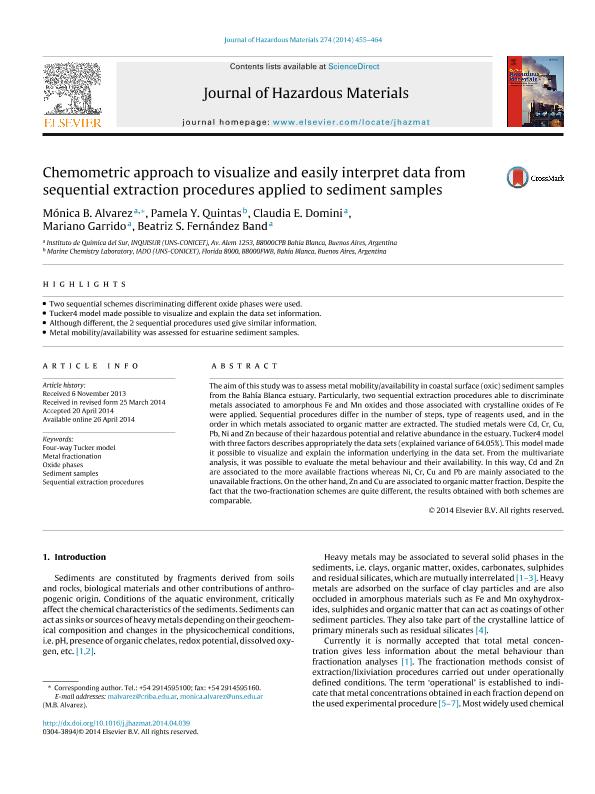Artículo
Chemometric approach to visualize and easily interpret data from sequential extraction procedures applied to sediment samples
Álvarez, Mónica Beatriz; Quintas, Pamela Yanina ; Domini, Claudia Elizabeth; Garrido, Mariano Enrique
; Domini, Claudia Elizabeth; Garrido, Mariano Enrique ; Fernández Band, Beatriz Susana
; Fernández Band, Beatriz Susana
 ; Domini, Claudia Elizabeth; Garrido, Mariano Enrique
; Domini, Claudia Elizabeth; Garrido, Mariano Enrique ; Fernández Band, Beatriz Susana
; Fernández Band, Beatriz Susana
Fecha de publicación:
04/2014
Editorial:
Elsevier Science
Revista:
Journal of Hazardous Materials
ISSN:
0304-3894
Idioma:
Inglés
Tipo de recurso:
Artículo publicado
Clasificación temática:
Resumen
The aim of this study was to assess metal mobility/availability in coastal surface (oxic) sediment samples from the Bahía Blanca estuary. Particularly, two sequential extraction procedures able to discriminate metals associated to amorphous Fe and Mn oxides and those associated with crystalline oxides of Fe were applied. Sequential procedures differ in the number of steps, type of reagents used, and in the order in which metals associated to organic matter are extracted. The studied metals were Cd, Cr, Cu,Pb, Ni and Zn because of their hazardous potential and relative abundance in the estuary. Tucker4 model with three factors describes appropriately the data sets (explained variance of 64.05%). This model made it possible to visualize and explain the information underlying in the data set. From the multivariate analysis, it was possible to evaluate the metal behaviour and their availability. In this way, Cd and Zn are associated to the more available fractions whereas Ni, Cr, Cu and Pb are mainly associated to the unavailable fractions. On the other hand, Zn and Cu are associated to organic matter fraction. Despite the fact that the two fractionation schemes are quite different, the results obtained with both schemes are comparable.
Archivos asociados
Licencia
Identificadores
Colecciones
Articulos(IADO)
Articulos de INST.ARG.DE OCEANOGRAFIA (I)
Articulos de INST.ARG.DE OCEANOGRAFIA (I)
Citación
Álvarez, Mónica Beatriz; Quintas, Pamela Yanina; Domini, Claudia Elizabeth; Garrido, Mariano Enrique; Fernández Band, Beatriz Susana; Chemometric approach to visualize and easily interpret data from sequential extraction procedures applied to sediment samples; Elsevier Science; Journal of Hazardous Materials; 274; 4-2014; 455-464
Compartir
Altmétricas



